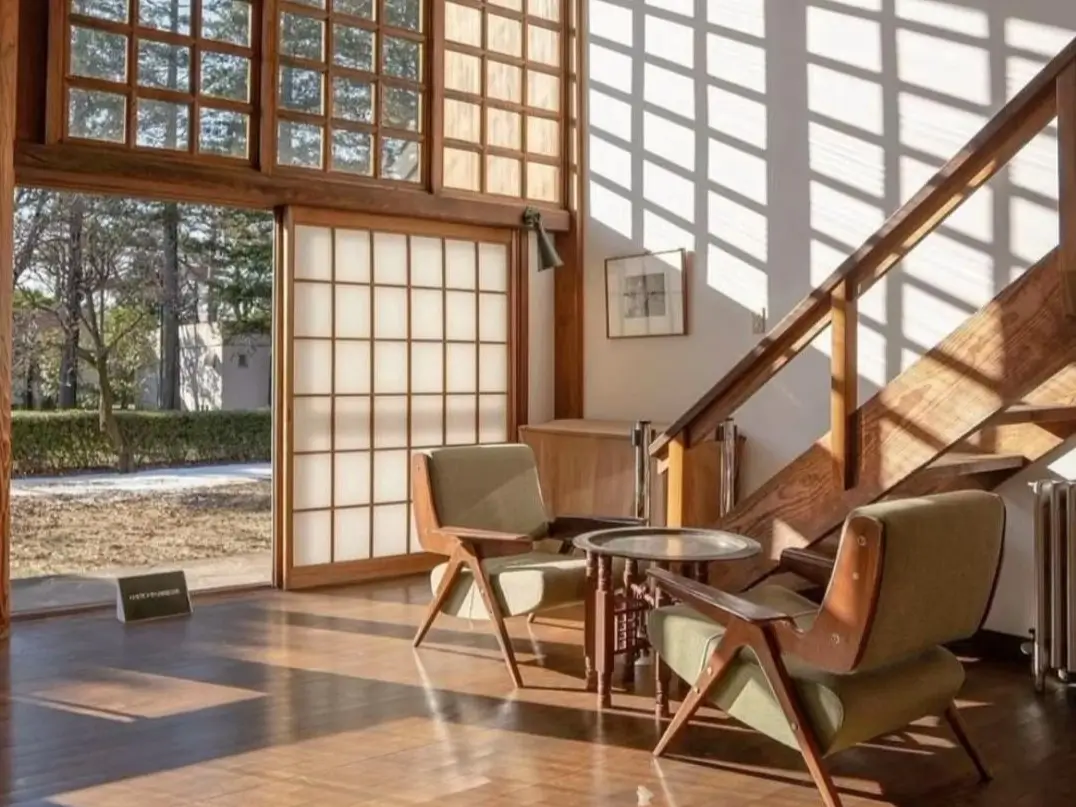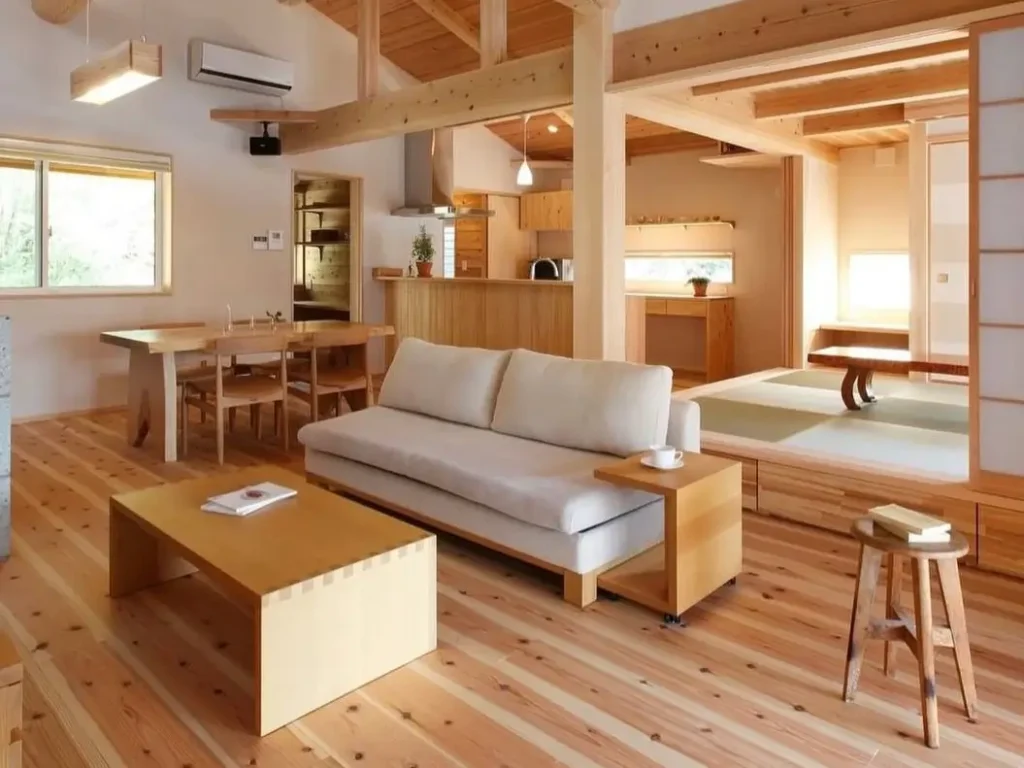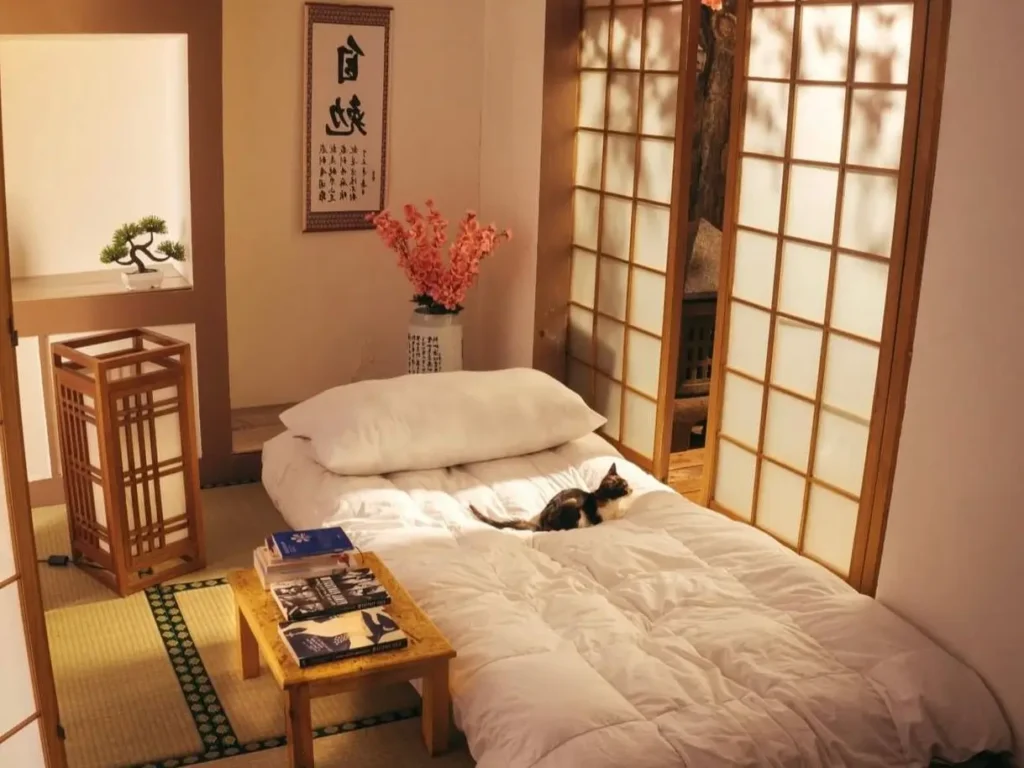Beautifully balanced design emerges when two strong aesthetics merge, and none do so more seamlessly than in Japandi style homes. This hybrid philosophy masterfully weds Scandinavian functionality with the timeless, rustic minimalism of Japanese design. The result is an environment that feels both curated and calm, intentionally uncluttered yet deeply inviting.
At its core, this look is a study in contrasts: the cozy, comforting nature of ‘hygge’ meets the imperfect, transient beauty of ‘wabi-sabi.’ A successful Japandi house design relies on a foundation of neutral, earthy palettes, rich natural textures like wood and stone, and a strong emphasis on clean, functional lines. Every piece serves a purpose, contributing to a sense of order and tranquility.
Achieving this look, however, is about more than just aesthetics; it’s about crafting a feeling. From foundational principles to the finishing touches of modern Japandi interior design, this guide provides the inspiration and practical advice needed to translate this sophisticated, serene style into your own home.
The Core Principles of Japandi Design
Before exploring the inspiration, it’s helpful to understand the key elements that define the Japandi look. This style is a careful balance of two philosophies, brought together by these shared values.
- Natural Materials: Woods like oak, maple, and bamboo are foundational. These are complemented by other natural textures like stone, rattan, linen, and textured paper, creating a strong connection to the earth.
- Muted Color Palette: The palette is rooted in neutral, warm, and earthy tones. Think beige, cream, taupe, and mushroom gray. Soft accent colors are drawn from nature, such as muted sage green, terracotta, and charcoal black.
- Simplicity and Function: Following the Scandinavian principle of hygge (coziness) and the Japanese focus on minimalism, every piece of furniture is chosen for its purpose, comfort, functional design, and clean, simple lines.
- Wabi-Sabi & Imperfection: This Japanese concept celebrates the beauty of imperfection. This appears in handmade ceramics, rustic wood, limewash walls, and items that show craftsmanship and age.
- Connection to Nature: Large windows for natural light, indoor plants like bonsai or delicate branches, and a seamless flow between indoors and outdoors are essential.
The Origins of Japandi Style
This beautiful blend is not a new trend but a natural partnership. Japanese and Scandinavian design have long shared a core philosophy. Both aesthetics are rooted in minimalism, a deep respect for natural materials, and a celebration of craftsmanship.
The style essentially pairs Scandinavian hygge (a feeling of cozy contentment) with the Japanese concept of wabi-sabi (finding beauty in imperfection). The result is a perfect balance. It is minimal but warm, functional but serene, and modern yet timeless.
Foundational Ideas for Japandi Style Homes
These images explore the core architectural and textural elements that create the foundation for a serene Japandi home, from the outside in.
1. Blend Exterior Materials

Concrete planes create a strong minimalist facade. This balance is softened by vertical wood slats. The raw and refined materials perfectly capture the aesthetic of a Japandi style home from the outside.
2. Play with Light
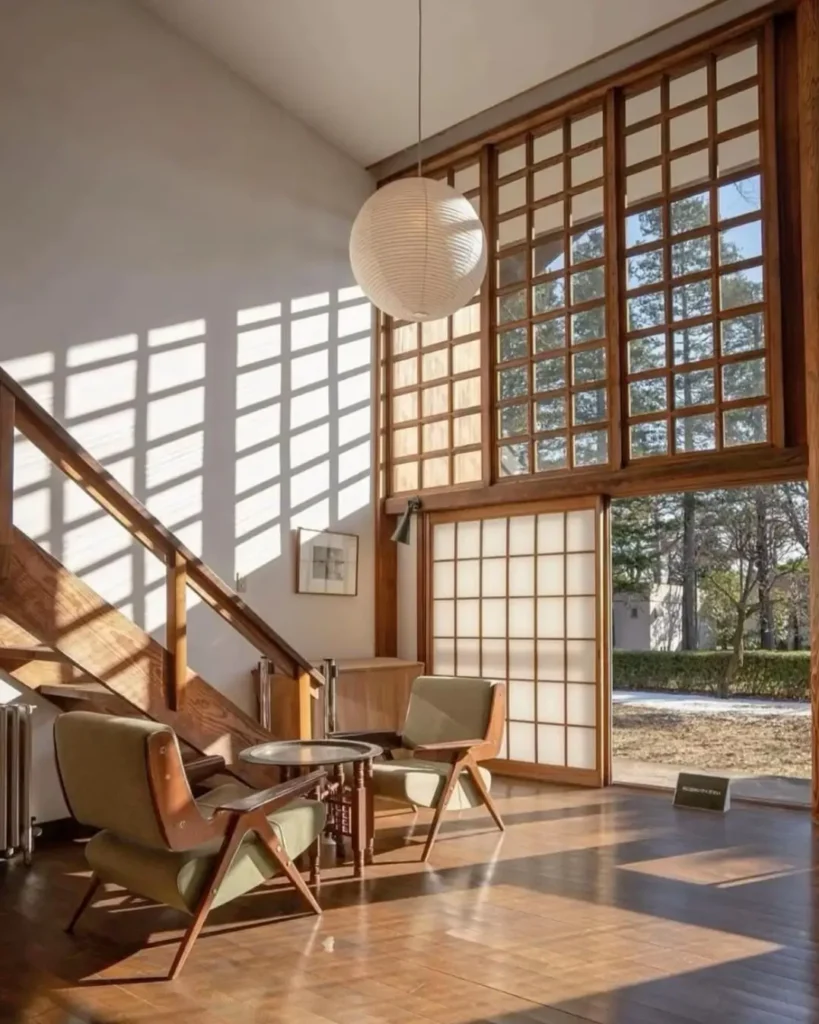
Dramatic, grid-paned windows, reminiscent of shoji screens, allow sunlight to create dynamic patterns across the space. This celebration of light, paired with warm wood flooring and mid-century seating, defines this tranquil modern Japandi interior design.
3. Layer Serene Spaces

Wood-paned doorways create a beautiful frame for the tranquil room beyond. Classic shoji screens, a low-profile slat table, and a glowing paper lantern combine for a perfectly balanced and tranquil Japandi interior.
4. Embrace Soft Minimalism
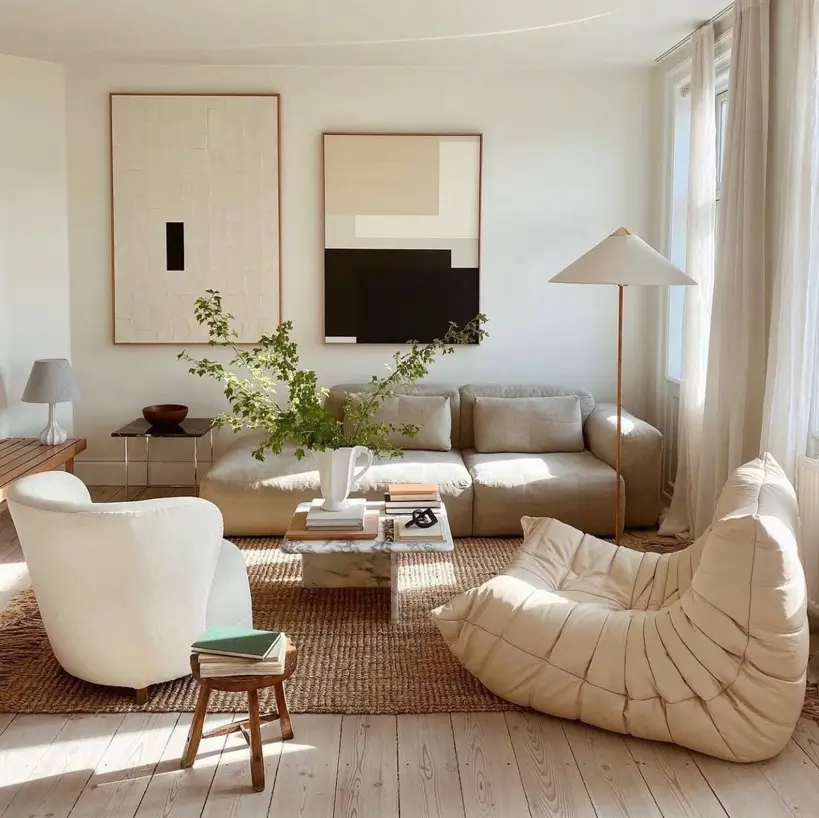
Soft, sculptural seating and light wood floors set a clear Scandinavian tone. This look is grounded by earthy, Japanese-inspired elements like a natural jute rug and a rustic wood stool. Abstract, neutral art and ample sunlight complete this serene, modern Japandi interior design.
5. Blend Cultural Pieces

Gold-leaf byōbu screens and a hanging scroll set a traditional Japanese backdrop. This is balanced by a soft, curved bouclé loveseat and a mid-century wood-frame chair, adding essential Scandinavian warmth and comfort.
6. Focus on Texture
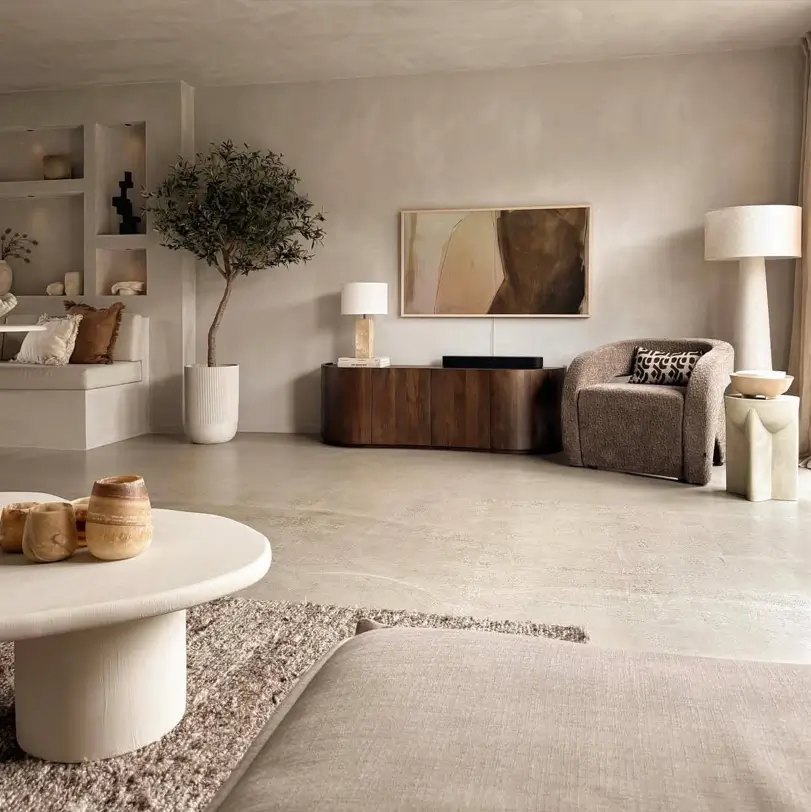
Limewash walls and micro-cement floors create a seamless, tactile foundation. This earthy, wabi-sabi envelope is softened by curved furniture, a richly textured rug, and a dark wood credenza, achieving a warm, minimalist feel.
7. Use Tonal Wood
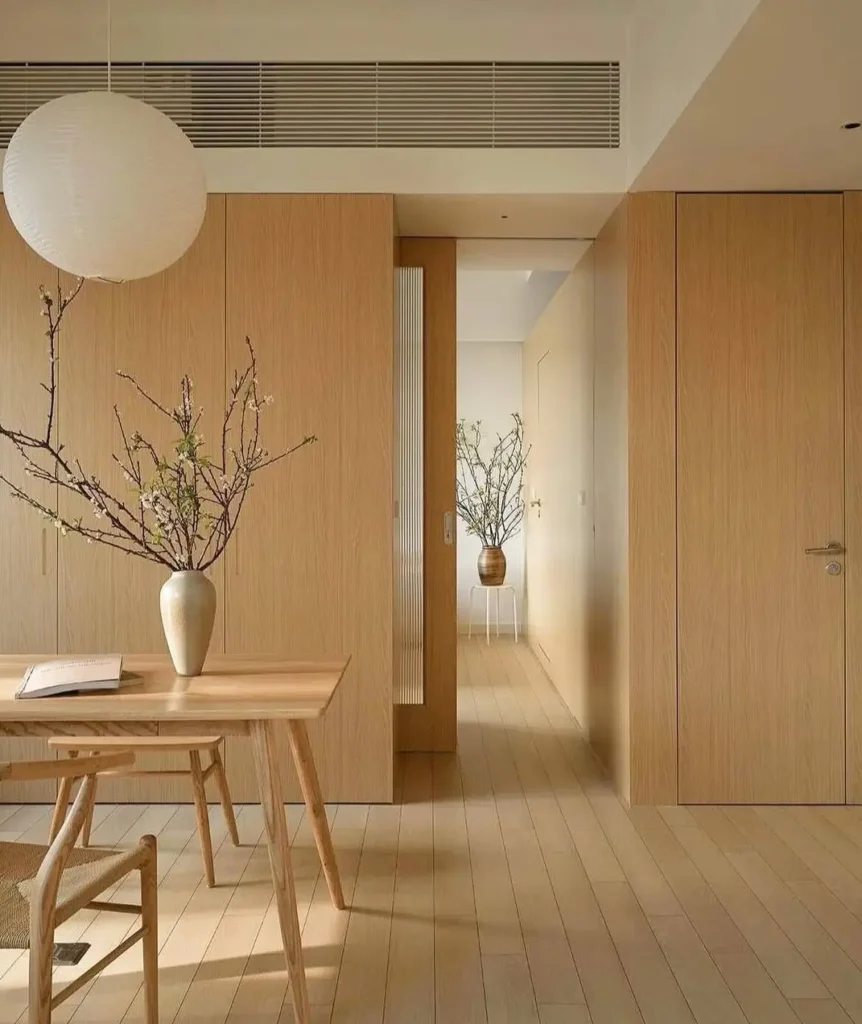
Tonal, light-wood planks seamlessly cover the floors and rise up the walls as handle-less cabinetry. This “wood-cocoon” effect creates ultimate serenity, thoughtfully punctuated by a woven-cord chair and a classic paper lantern.
8. Use Muted Tones
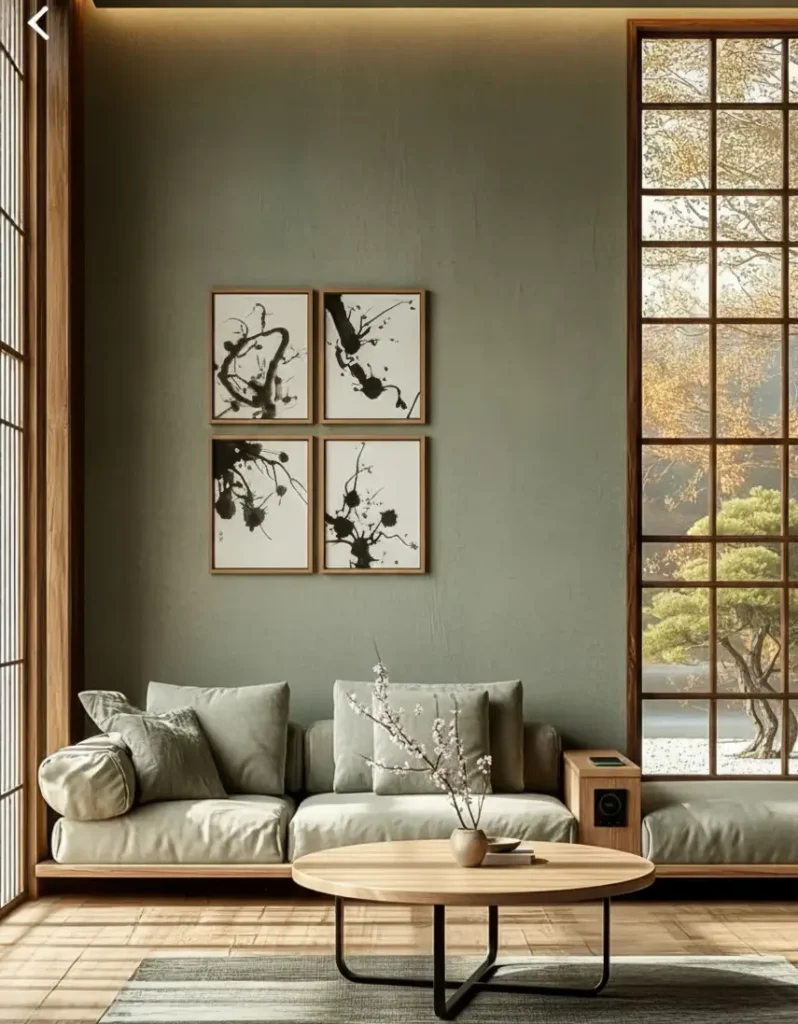
Muted, sage-green walls create a tranquil backdrop, referencing a core natural palette. This earthy tone complements the expansive, grid-paned window and a low-profile sofa set in a wood frame. Framed ink-wash art adds a graphic, Japanese-inspired focal point.
9. Introduce Dark Accents

Sculptural ebonized wood chairs create a striking contrast against a rustic heavy-grain dining table. This pairing is set within a room of warm terracotta limewash walls. The dark accents balance beautifully with an earthy wabi-sabi foundation.
10. Create a Courtyard
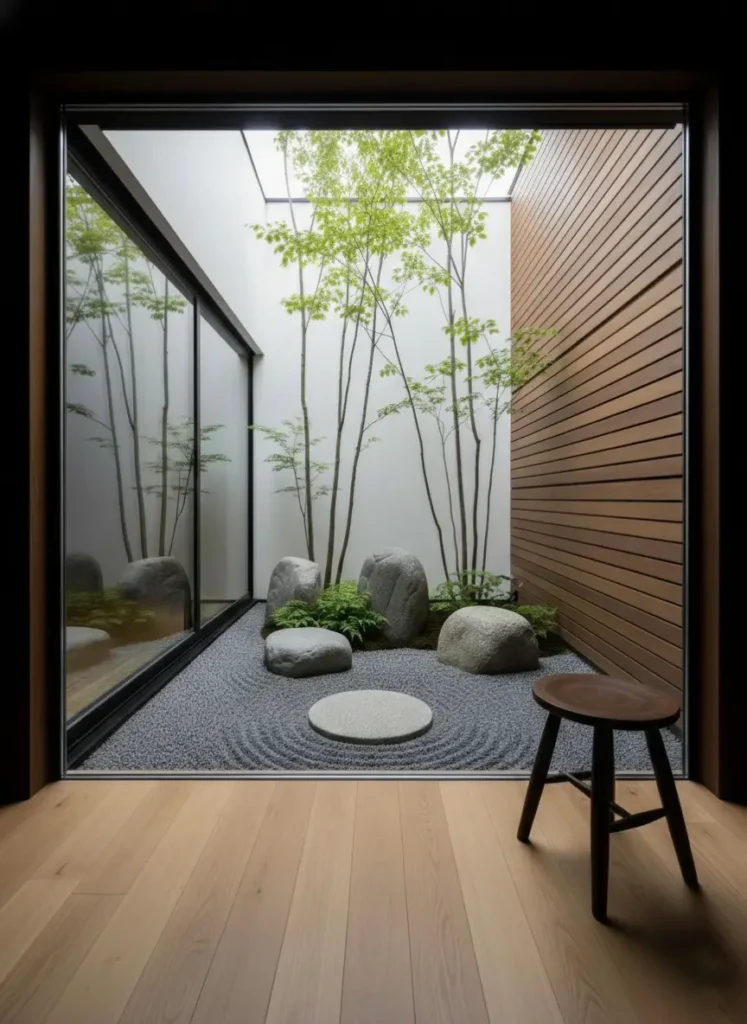
Small enclosed courtyards or tsuboniwa act as living art. This private garden is a key feature in Japandi house design. It brings natural light and a meditative quality deep into the home.
11. Design with Shadow
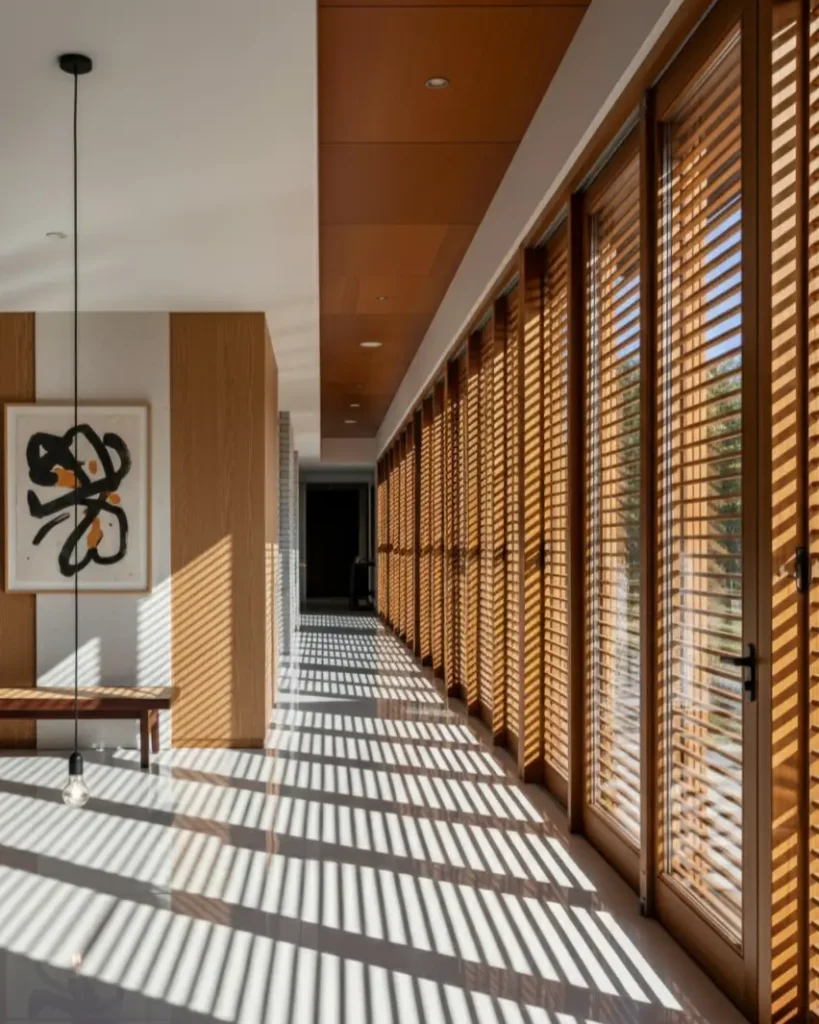
Long banks of wood-louvered doors transform this hallway. Sunlight streams through to cast a rhythmic pattern of light and shadow. This effect animes the minimalist space.
Modern Japandi Interior Design by Room
See how these principles are applied in different areas of the home, from serene living spaces and kitchens to tranquil bedrooms and spa-like bathrooms.
12. Design a Japandi Bedroom

Custom wood paneling creates a warm architectural feature wall. Softness comes from the rust-colored headboard and layered linens. The simple ceramic pendant adds a cozy hygge-inspired touch.
13. Create a Japandi Office
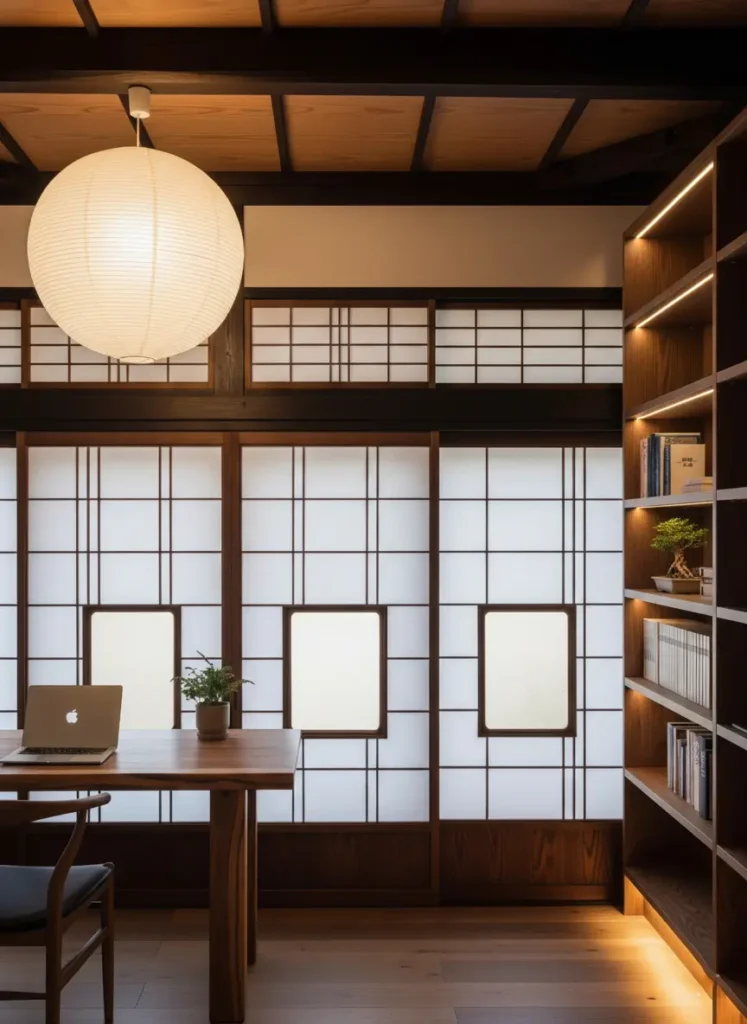
Dark wood shoji screens define this focused workspace. An exposed beam ceiling adds authentic Japanese character. Sleek built-in shelving with inset lighting offers a modern functional contrast.
14. Frame Nature’s View

Large picture windows become a natural work of art. They perfectly frame the dense forest. This “borrowed scenery” complements dark wood furniture and a traditional Japanese scroll. The room feels moody and deeply contemplative.
15. Style a Japandi Kitchen
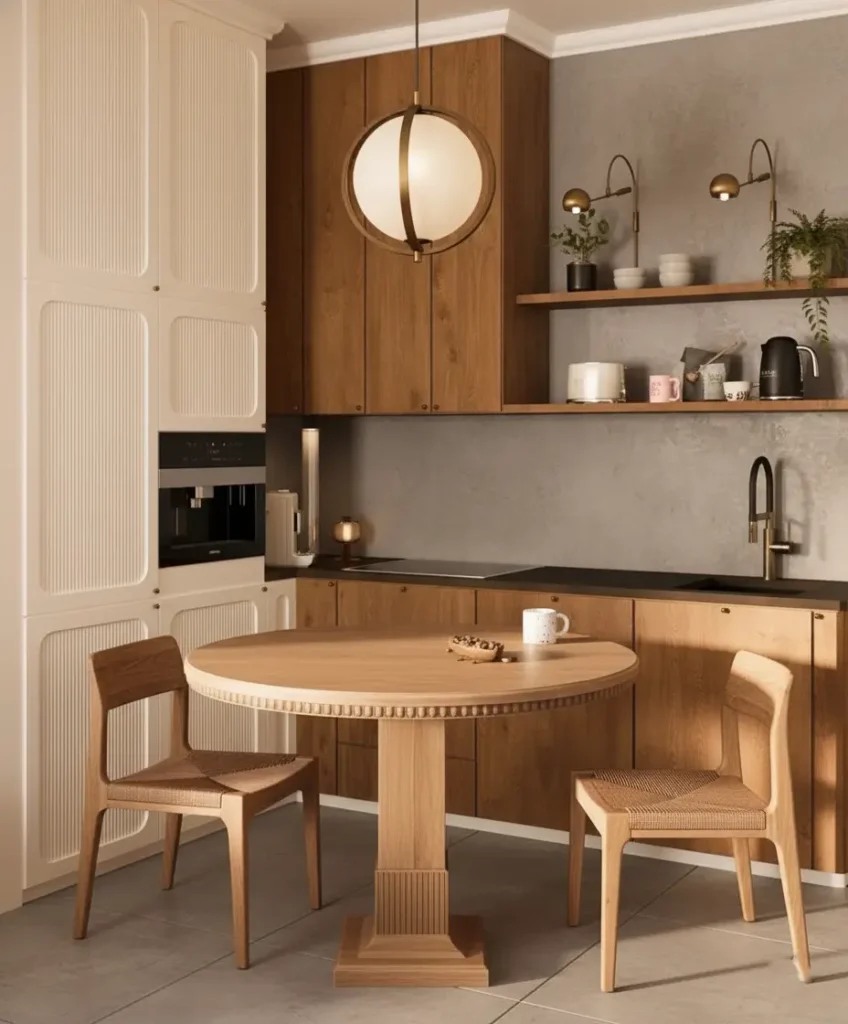
Natural wood cabinets bring warmth to the kitchen. Cream-colored reeded panels add subtle modern texture. Woven rush chairs give classic Scandinavian comfort. This design achieves a perfect functional balance.
16. Illuminate Double Height
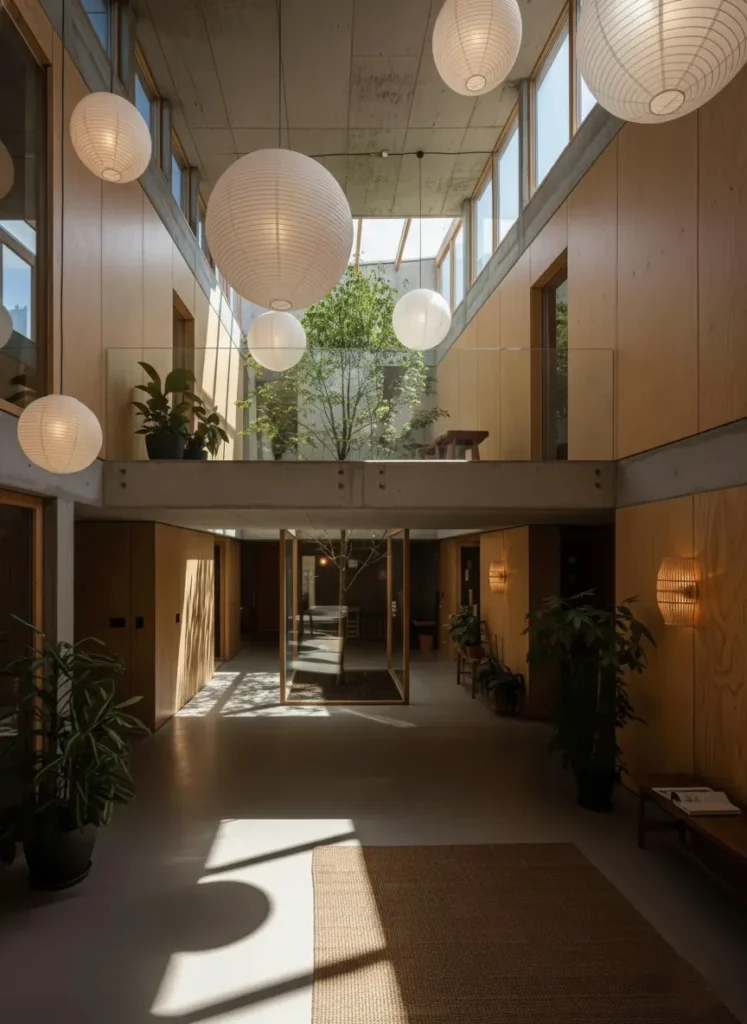
Dramatic double-height atriums combine raw concrete and warm wood. This design is a breathtaking feature in a modern Japandi style home. Central courtyard trees and paper lanterns fill the vertical space.
17. Integrate Seamless Storage
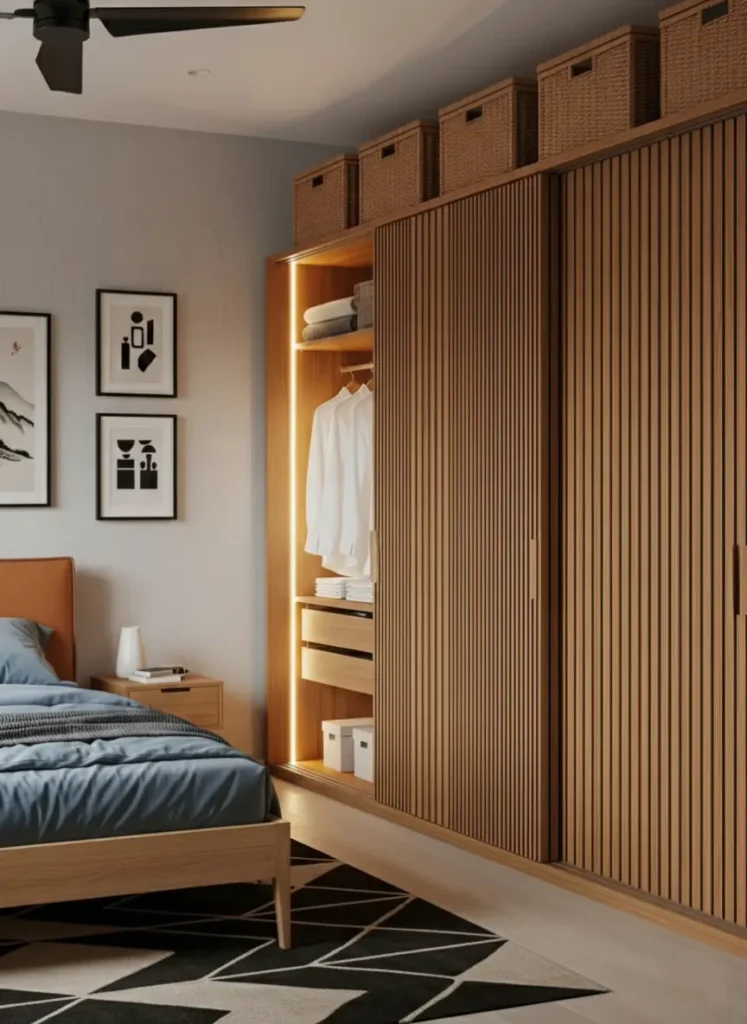
Floor-to-ceiling wardrobes feature vertical wood slats. This design adds texture while cleverly concealing storage. Integrated lighting and woven baskets above maximize function. The space feels both organized and serene.
18. Carve Display Niches

Built-in shelving niches add architectural depth. Their textured plaster finish provides a perfect wabi-sabi backdrop. Curated ceramics and sculptures are displayed. Light wood chairs add a soft Scandinavian touch.
19. Set a Japandi Dining Room

A dark-stained oak table and matching curved chairs create a grounded dining space. This rich wood is balanced by a sleek modern fireplace and a sculptural paper-like pendant light. The look is both sophisticated and serene.
20. Arrange a Japandi Living Room

Soft sculptural seating provides Scandinavian comfort. This bright living room is grounded by a large natural fiber jute rug. Black-framed windows and minimalist art provide strong graphic contrast.
21. Cocoon in Plywood
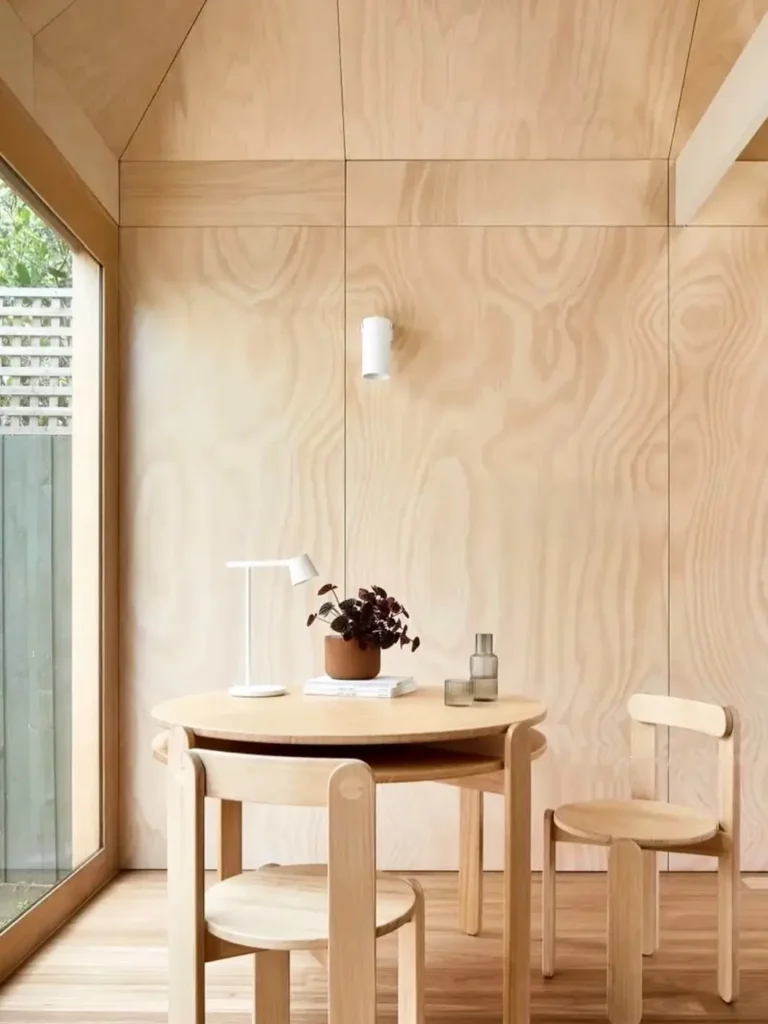
Plywood-paneled walls and ceilings create a warm bright interior. The prominent wood grain adds natural pattern. Simple light wood furniture and minimalist lighting complete this Scandi-inspired nook.
22. Build Platform Seating
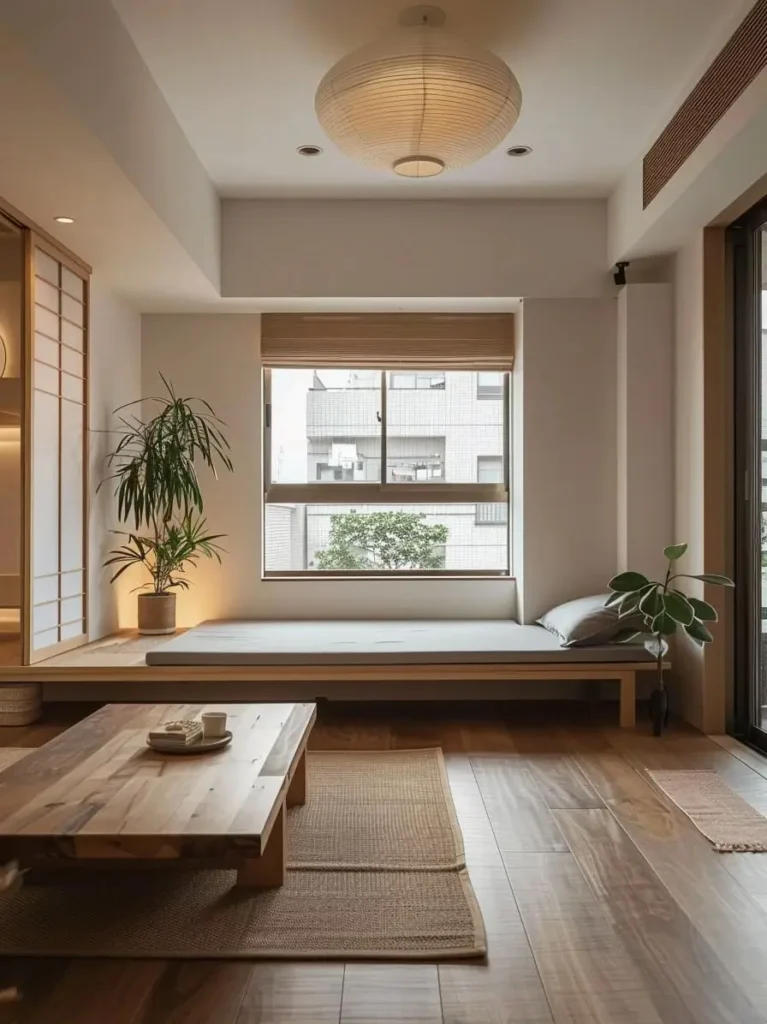
A low-profile wood platform daybed creates a multi-functional lounging space. This setup is a hallmark of Japandi house design. It is paired with a rustic low table and shoji-style screens.
23. Layer Natural Textures

Low-profile wood-framed seating features heavily textured cushions. Floating shelves display a curated collection of wabi-sabi ceramics. Paper lanterns woven tabletop items and dried botanicals add layers of soft organic warmth.
24. Blur Indoor-Outdoor

Sliding glass doors open completely to a central courtyard. This design merges the living space with nature. Traditional sudare reed blinds filter sunlight. The low table and indoor plants enhance the organic serene connection.
25. Unify with Cabinetry
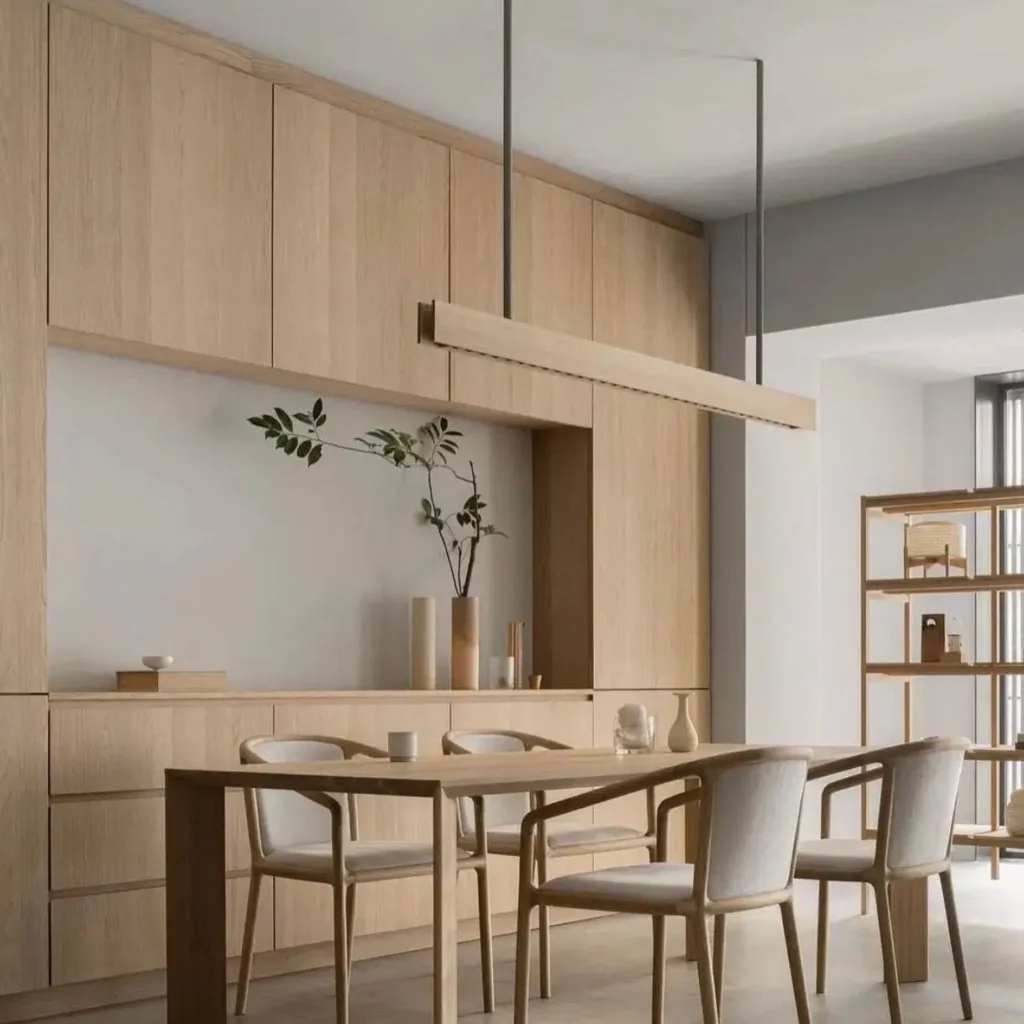
Seamless floor-to-ceiling cabinetry in light oak creates a clean functional backdrop. The dining set’s matching wood tones and soft upholstery continue the serene theme. A minimalist linear pendant adds a sharp modern accent.
26. Craft a Japandi Bathroom

Vertical wood slats and a floating vanity create a spa-like retreat. Stone vessel sinks a deep soaking tub and a river pebble border are strong natural elements. This bathroom masterfully blends Japanese onsen culture with modern design.
27. Layer Form and Texture

Reeded wall panels create a strong linear backdrop. Softness comes from the curved sofa. A concrete coffee table adds organic weight. Minimalist ink art completes the sophisticated look.
28. Embrace Dark Tones
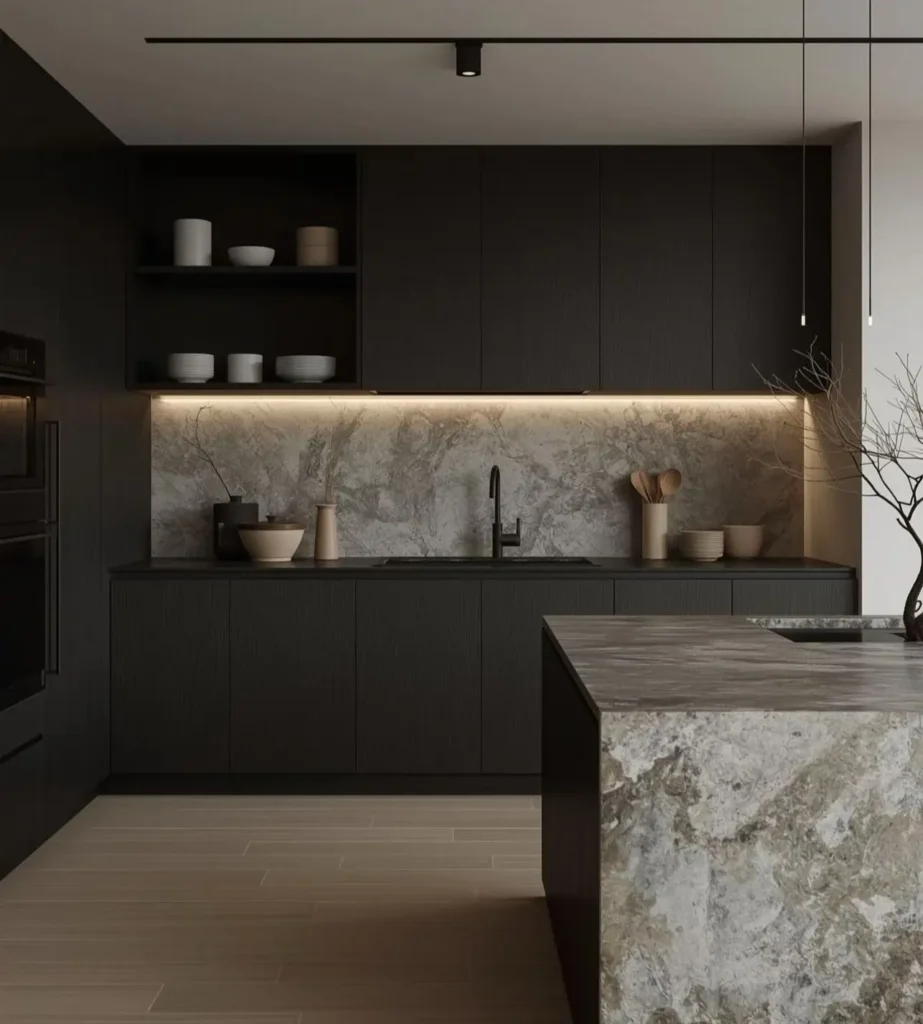
Dark wood cabinets create a moody sophisticated feel. Heavily veined stone adds dramatic natural texture. The backsplash and island become a focal point. Warm lighting and light floors provide beautiful balance.
29. Extend Living Outward

Minimalist architecture defines this Japandi style home. Expansive glass walls slide away to connect the interior with a serene pool. Vertical wood slats provide texture privacy and warmth.
30. Embrace Wabi-Sabi Bedroom

Imperfect textures are celebrated in this bedroom. The limewash wall rumpled linen and rustic ceramic vase create a tactile experience. A solid wood side table and woven stool add layers of natural organic warmth.
31. Use Rustic Elements
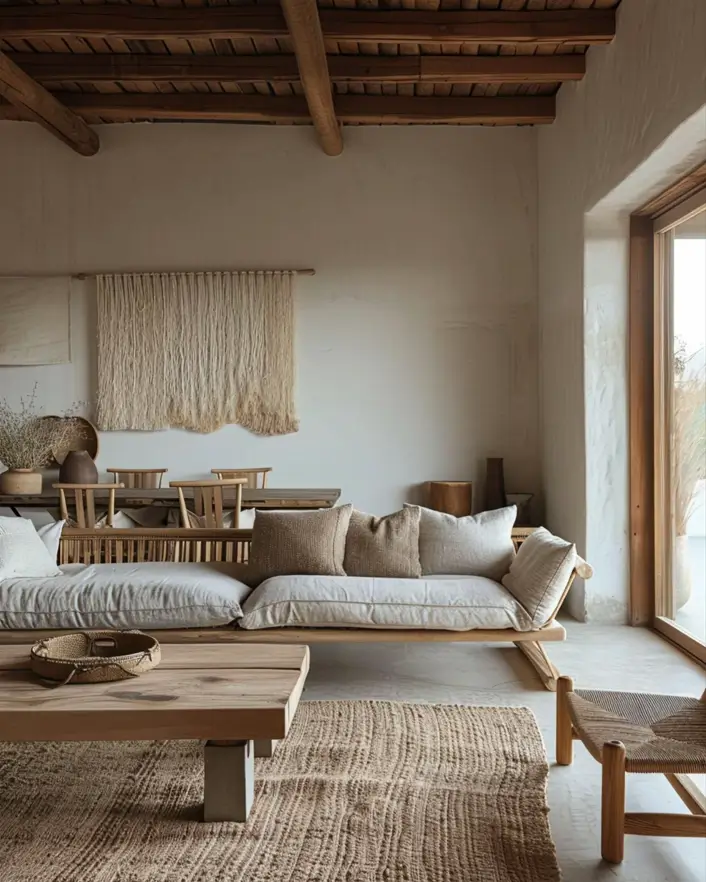
Exposed wood beams and a raw timber ceiling set a rustic tone. This wabi-sabi approach is central to a rustic Japandi house design. A low-profile wood sofa and a heavy-grain coffee table add to the natural feel.
32. Combine Iconic Pieces

Iconic Scandinavian chairs pair beautifully with a solid wood pedestal table. A Japanese-inspired slatted screen divides the space. This design creates functional zones without blocking light. A paper lantern adds essential soft illumination.
33. Design a Wabi-Sabi Bathroom
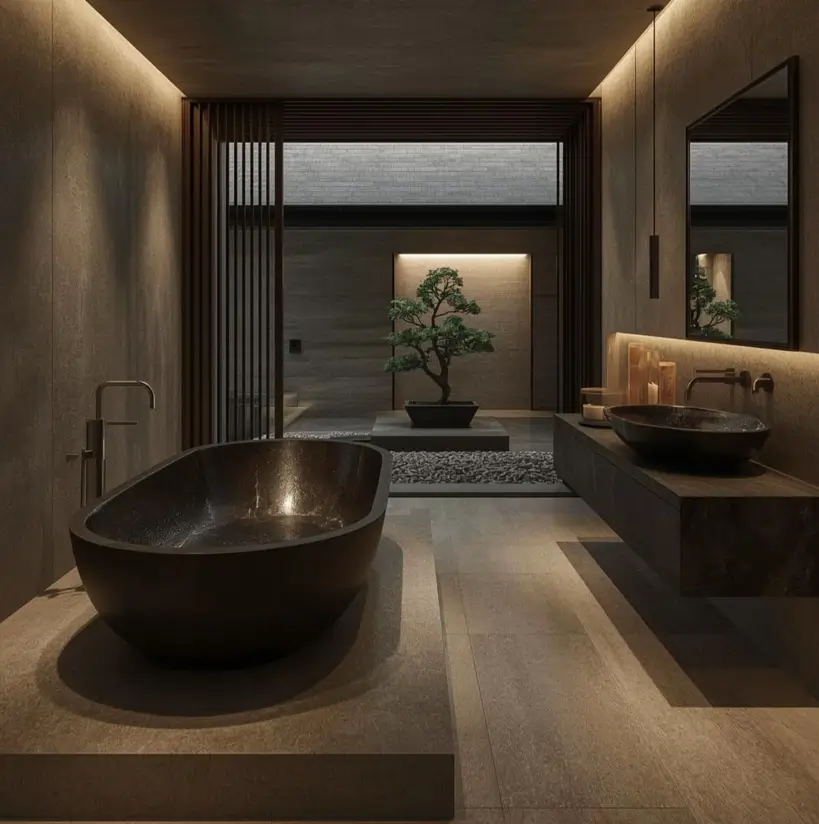
Monolithic stone tiles cover the walls floors and ceiling. This design creates a moody cave-like sanctuary. A sculptural freestanding tub and stone vessel sinks add wabi-sabi form. The bonsai tree provides a living meditative focal point.
Key Details in Japandi House Design
The final layer of a successful Japandi home comes from the specific, intentional details that tie the space together, from furniture choices to artful decor.
34. Style a Japandi Dining Nook
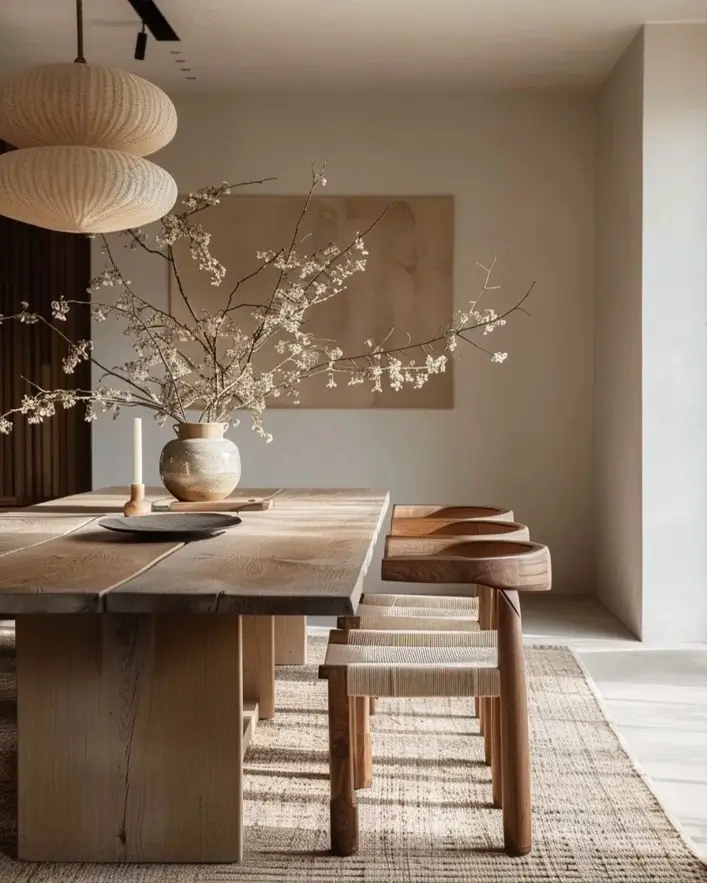
A rustic heavy-grain wood table creates an inviting focal point. Woven-seat chairs add classic Scandinavian comfort and craftsmanship. This earthy pairing is softened by layered paper pendants and delicate blossoms.
35. Design a Japandi Entryway

Vertical wood slats create a warm rhythmic entryway. This design is a tranquil welcome into a Japandi style home. An organic border of river pebbles and a floating console complete the space.
36. Choose Rustic Furniture
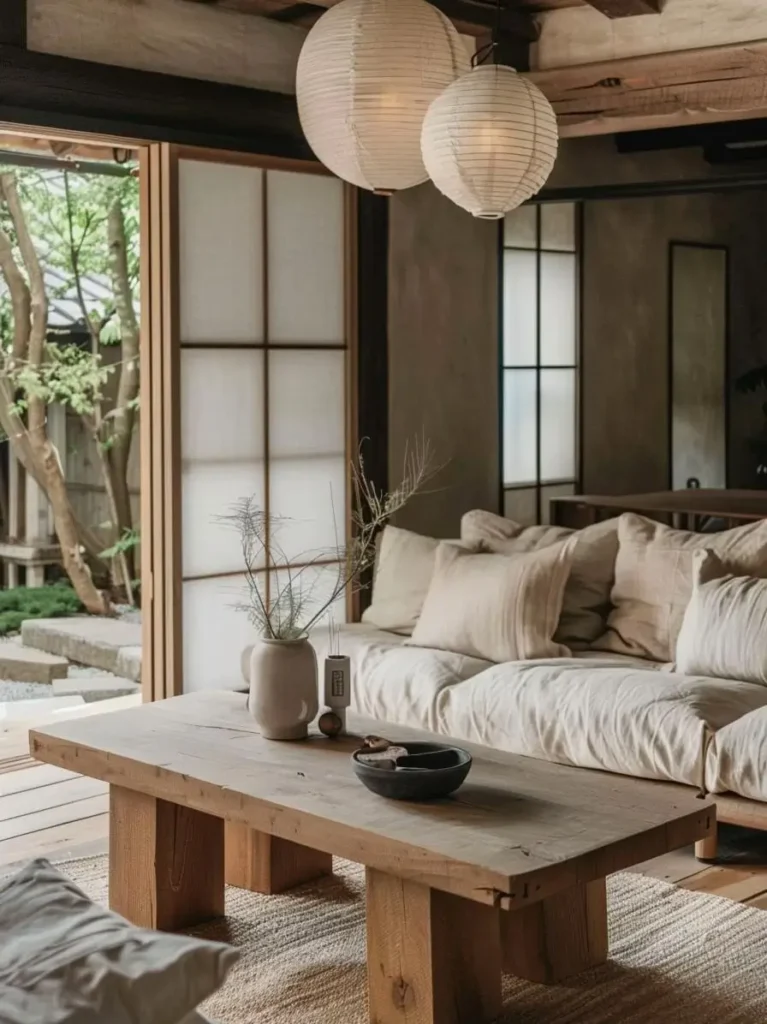
Solid rough-hewn furniture provides essential wabi-sabi texture. A heavy timber coffee table grounds the soft linen sofa. Traditional shoji screens and paper lanterns complete this authentic space.
37. Detail the Materials
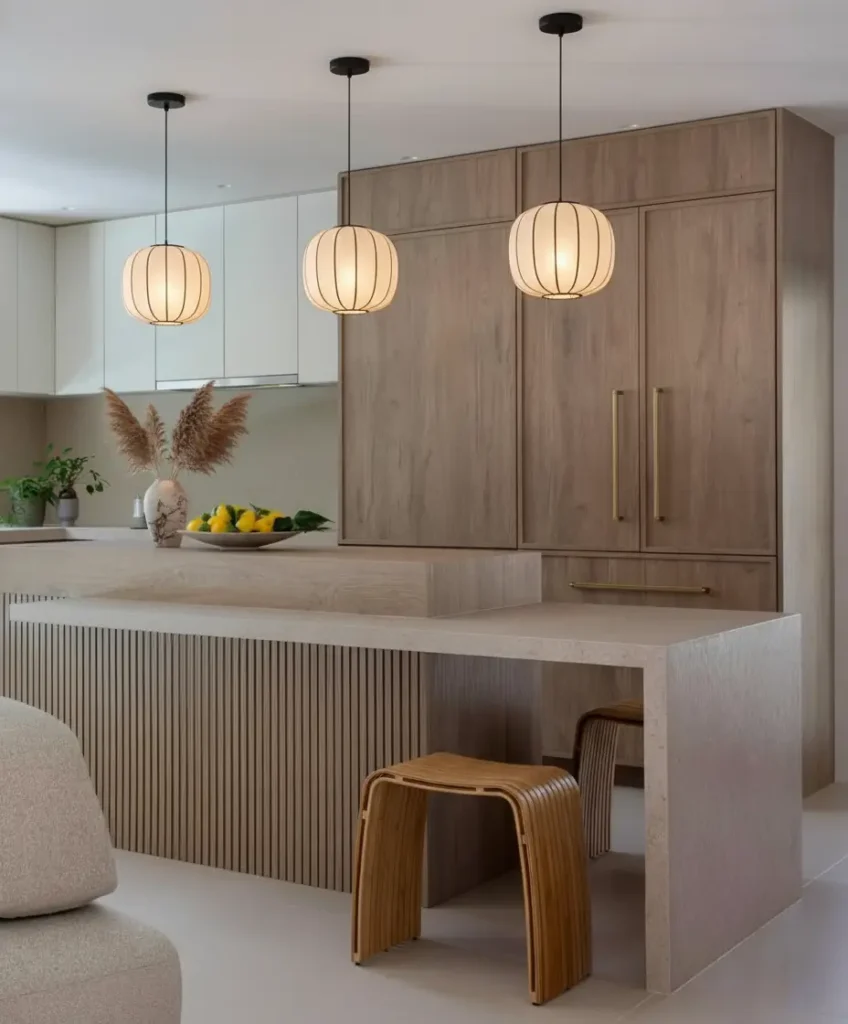
Designed by Quarter2one Studio, this kitchen masters material blending. Vertical wood slats meet a durable Rovere Buckskin island. Soft-toned Dekton countertops and simple pendants complete the sophisticated, functional look.
38. Embrace Low-Level Living
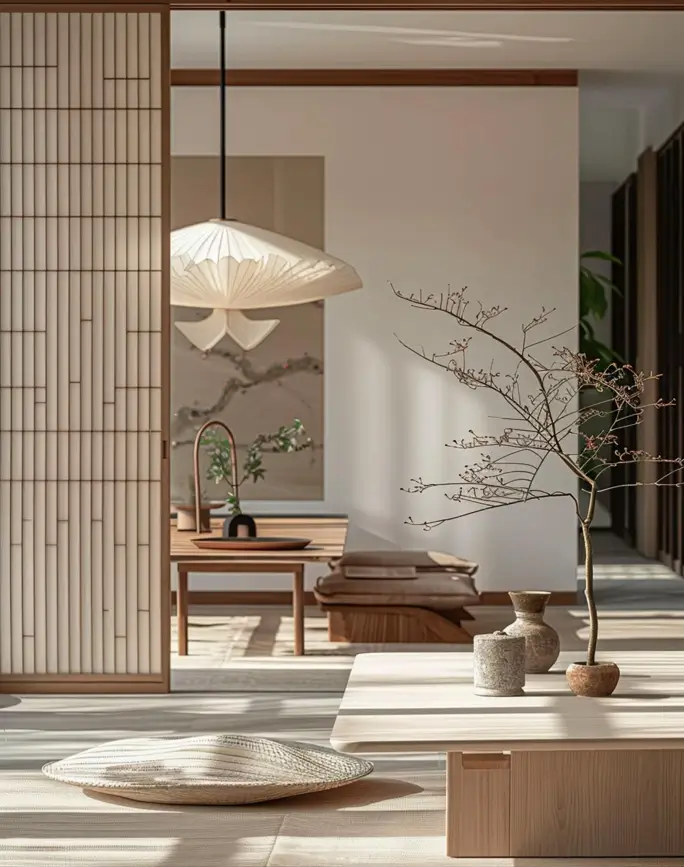
A low wooden table and floor cushions encourage a grounded lifestyle. This Japanese-inspired practice creates an intimate calm atmosphere. Wabi-sabi ceramics and a textured screen add layers of simple elegance.
39. Master Artful Simplicity
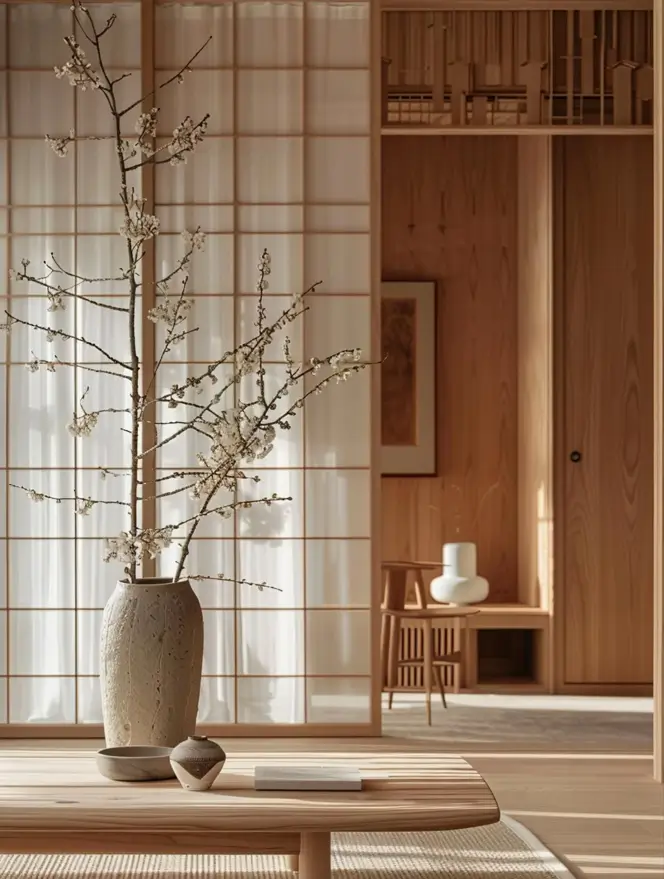
Light wood shoji screens diffuse sunlight creating a soft serene glow. A rustic wabi-sabi vase with delicate branches acts as a simple artful focal point. The entire wood-wrapped scene is a masterful study in calm.
40. Layer Architectural Forms

A strong horizontal roofline defines this modern Japandi style home. The facade layers vertical wood slats textured panels and large glass expanses. Raked-gravel landscaping adds a classic Japanese garden element.
How to Get the Japandi Look in Your Home
Translating this inspiration into your own Japandi style home is about balance and intention. Here are five practical steps to begin:
- Start with a Neutral Palette: Swap bright, jarring colors for a foundation of warm whites, beiges, or light grays. Add depth with earthy accents like olive green, terracotta, or charcoal.
- Declutter and Curate: This style is intentionally minimal. Remove clutter and select only functional or beautiful objects. Give each item “room to breathe.”
- Invest in Natural Materials: Introduce pieces made of natural wood, whether it’s a simple oak chair, a bamboo screen, or a maple coffee table.
- Contrast Textures: Pair smooth with rough. Combine a soft linen sofa with a natural jute rug, or sleek concrete floors with warm wood paneling.
- Embrace Imperfect Decor: Look for items with character. A handmade ceramic vase, a rustic wooden bowl, or a rumpled linen throw add the essential wabi-sabi soul.
Key Furniture and Decor Elements
While the feeling is most important, certain key pieces help establish the look. This scannable list covers the essentials that blend form and function.
- Low-Profile Furniture: Choose sofas, daybeds, and tables that sit low to the ground. This creates a grounded, calming atmosphere, a hallmark of Japanese-inspired living.
- Paper Lanterns: Use classic rice paper or modern fabric pendants. They provide a soft, diffused glow that is essential for eliminating harsh lighting.
- Woven-Seat Chairs: Add iconic Scandinavian-designed chairs. Their woven rush or cord seats add a light, functional, and crafted touch.
- Natural Fiber Rugs: Ground the space with jute, sisal, or wool. These rugs provide crucial texture and warmth to balance wood or concrete floors.
- Wabi-Sabi Ceramics: Display handmade, rustic vases and bowls. Their imperfect shapes and earthy glazes add the essential wabi-sabi soul.
- Minimalist, Low Beds: Use simple wood platform beds or low-profile frames. This maintains the uncluttered, serene philosophy in the bedroom.
Common Pitfalls to Avoid
Achieving this delicate balance can be tricky. A few common missteps can throw off the entire feel of the room.
1. Making It Too Cold
A space can easily become sterile if you lean too hard into minimalism. Avoid this by layering textures. Add a linen throw, a textured rug, and warm wood tones to ensure the room feels cozy.
2. Confusing Clutter with Warmth
The “hygge” element should not be an excuse for clutter. Every object should feel intentional. If a surface is covered, the serene, functional aspect of the design is lost.
3. Forgetting Wabi-Sabi
A room filled with only new, perfect, mass-produced items will lack soul. This style needs the imperfect touch. Add a vintage stool, a rustic vase, or a piece of art with character.
Frequently Asked Questions
What Defines the Japandi Style?
Japandi is a hybrid design style. It merges Scandinavian functionality with Japanese rustic minimalism. The style focuses on clean lines natural materials and a calm uncluttered feeling.
What Are the Key Elements of a Japandi House Design?
Focus on natural materials like wood stone and linen. Use a muted earthy color palette. Choose simple functional furniture with clean lines. Finally embrace imperfection and minimalism or wabi-sabi.
How Does Japandi Design Differ From Scandinavian?
Scandinavian design often features bright white walls and cooler tones. Japandi introduces warmer natural tones and the Japanese principle of wabi-sabi. This adds more texture and celebrates imperfection.
What Is the Typical Color Palette for Modern Japandi Interior Design?
The palette is primarily neutral and earthy. Base colors include warm white beige taupe and stone gray. Common accent colors are soft greens like sage, warm earth tones like terracotta, and deep-contrast shades like charcoal black or indigo.
What is the difference between Japandi and Wabi-Sabi?
This is a common question. Wabi-sabi is a traditional Japanese philosophy centered on finding beauty in imperfection and transience. Japandi is a modern design style that blends Scandinavian and Japanese aesthetics. Japandi uses the wabi-sabi philosophy as one of its core principles.
How is Japandi different from Minimalism?
This is a common comparison. Minimalism focuses purely on “less is more” and can sometimes feel cold or stark. Japandi is warmer. It uses minimalist principles but adds the Scandinavian hygge (coziness) and Japanese wabi-sabi (imperfect, natural textures) to create a space that is both uncluttered and inviting.

